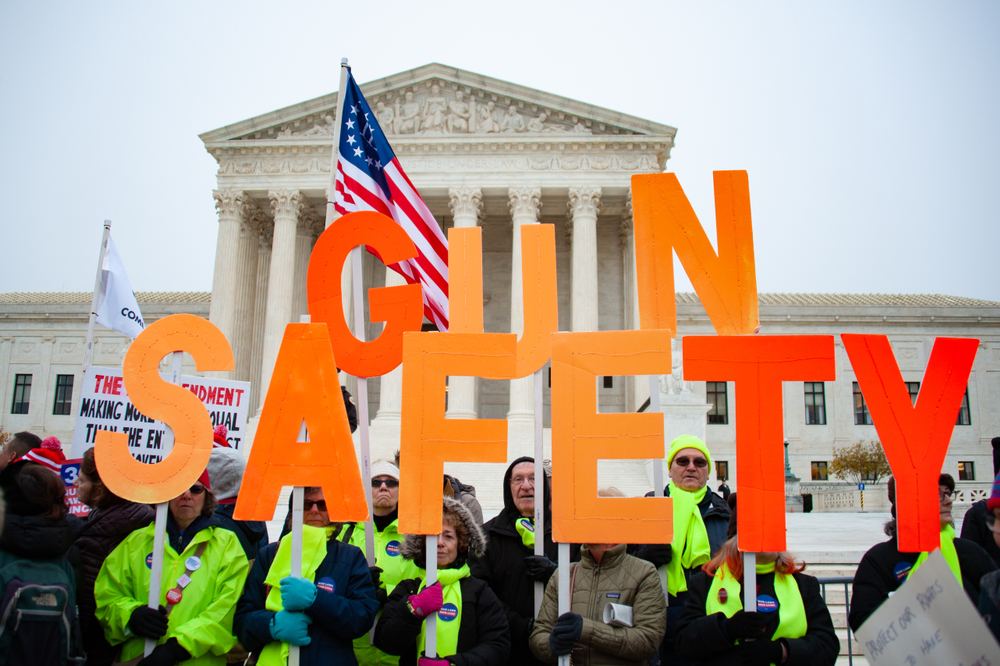15 Years After Heller, Bruen is Unleashing Chaos, But There’s Hope For Gun Regulations

A scene from the 2019 Gun Laws Save Lives Rally in front of the Supreme Court. CREDIT: Shutterstock/Rena Schild

For two centuries, judges and scholars generally agreed that the Second Amendment protects a collective right to bear arms in defense of the state — until the Supreme Court decided District of Columbia v. Heller 15 years ago this week. The consequences of that decision are still unfolding today.
The Second Amendment reads: “A well regulated Militia, being necessary to the security of a free state, the right of the people to keep and bear arms shall not be infringed.” For years, courts weighed gun laws in relation to whether those laws furthered a well-regulated militia. For example, in United States v. Miller, decided in 1939, the Supreme Court upheld the federal restriction on sawed-off shotguns on the basis that the Second Amendment only protects weapons that have “some reasonable relationship to the preservation or efficiency of a well regulated militia.” Courts in the decades after Miller upheld all manner of gun regulations following that reasoning.
The “collective right” consensus began to change in the 1990s, when, as legal historian Saul Cornell writes, “a new wave of revisionist scholarship emerged.” The revisionism culminated with Heller, in which the Supreme Court upended all prior jurisprudence on the topic and held, for the first time, that the Second Amendment’s “central component” is individual self-defense and, as such, the Amendment protects an individual (rather than collective) right to possess a firearm in defense of “hearth and home.”
Because the Supreme Court only hears a select few cases each year, the lower courts were the center of post-Heller Second Amendment jurisprudence. Despite Heller’s shattering departure from the collective right consensus, the vast majority of gun laws — despite suddenly facing a spate of lawsuits — survived those post-Heller challenges in the district and appellate courts. These included bans on possessing assault weapons and large-capacity magazines, bans on carrying firearms in government buildings and public parks, and bans on possessing firearms for people in high-risk categories, such as those who have been convicted of felonies or are subject to domestic violence restraining orders.
And yet, there were outliers — radical judges who found long-standing gun regulations suddenly unconstitutional. Lower court decisions after Heller underscore why the appointment of judges to the district and appellate federal courts matters so much for the freedom and security of ordinary people.
2022’s Bruen Decision
This past June, the Supreme Court upended Second Amendment jurisprudence again in New York State Rifle & Pistol Association v. Bruen. In Bruen, the Supreme Court purported to build on Heller, distorting history to radically expand the Second Amendment right even further. The Court held, for the first time, that the Second Amendment right to keep and bear arms for self-defense extends outside the home, and it directed lawmakers and lower courts that gun regulations must “accord” with supposed historical understanding. For a law that regulates conduct protected by the plain text of the Second Amendment to be constitutional, says Bruen, it must be supported by analogous historical laws.
Bruen’s requirement that modern gun laws be consistent with the Second Amendment’s “historical understanding,” either on their face or via analogy, is problematic for three reasons.
First, this historical “standard” is not a standard at all. It is unclear what level of generality courts should apply when analogizing modern and early American gun laws. It is unclear what timeframe courts should consider as relevant history. And the “standard” relies on lawyers and judges pretending to be historians to determine whether we can remain safe from gun violence.
Second, requiring modern gun laws to mirror early American gun laws ignores the ways in which the country, body politic, and weapons technology have changed beyond recognition since early America. Early American governments brutalized Native Americans, enslaved Black Americans, and oppressed women, yet Bruen would empower those early governments’ judgments to “veto” today’s diverse electorate. Early American governments could not conceive of modern technology, like 3D printers that can produce guns and assault weapons that make it possible for lone shooters to commit mass murder in 90 seconds or even less. Yet Bruen would hinder today’s laws from regulating today’s technology.
Third, professional historians have explained that a fixed “historical understanding” of the Second Amendment right — or of anything else of this nature, for that matter — is a fallacy, but Justice Thomas’s majority opinion simply ignores that major problem. His opinion also ignores a historical record replete with support for robust gun regulation in the public square, conveniently explaining that “not all history is created equal,” and then discarding any history that Justice Thomas deems inconvenient in reaching his desired conclusion.
New Challenges
In the wake of Bruen, so-called “gun rights” advocates are again challenging numerous long-accepted firearms regulations. Just as they did after Heller, the lower courts will decide almost all of the post-Bruen Second Amendment questions, and the results so far are mixed.
One judge partially invalidated Delaware’s law banning “ghost guns,” which are unserialized, untraceable gun-kits that can be bought online and easily assembled at home, much like a piece of Ikea furniture — technology that would have been inconceivable in 1791. Another judge overturned a portion of New York’s law banning guns in places like churches, summer camps, and zoos. A judge in West Virginia held that the ban on possessing guns with obliterated serial numbers is unconstitutional. Perhaps the most extreme example is United States v. Rahimi. The U.S. Court of Appeals for the Fifth Circuit empowered recent, court-determined domestic abusers to possess firearms. Rahimi rejected the federal law barring such possession, partly on the astonishing basis that modern domestic violence restraining laws have no sufficient historical analogue in the 18th century.
This conclusion reflects precisely the problem with an expansive interpretation of Bruen and with the invention of historical tests more generally: From a legal and societal perspective, the status of women and children in 1791 completely — and fortunately — differs from how they are perceived and treated now. Tying the constitutionality of modern laws to 222-year-old social norms, which often considered white women and children, along with minoritized people of all ages and genders as a form of property, makes a mockery of the societal progress that has occurred in the more than two centuries since then. Likewise, tying the constitutionality of laws attempting to regulate assault-style rifles, semi-automatic handguns, and ghost guns to the era of muskets and flintlock pistols makes a mockery of the very real harm inflicted by gun violence. (A well-trained person could load and fire a single-shot musket only twice or so in a minute.)
Although certain judges have invalidated gun laws designed to protect some of the most vulnerable Americans in these early post-Bruen days, the appellate courts could just as easily reverse and uphold the laws, because Bruen’s malleable standard gives judges so much latitude.
Meanwhile, gun violence remains an undeniable and massive threat within nearly all areas in the United States. Researchers have associated more guns with more gun deaths, whether homicide or suicide. Indeed, following record high gun sales in 2020 and 2021, gun deaths rose. Shockingly, gun violence is the number one killer of American children. CDC data show that gun homicide rates rose by 8.1% in 2021, leaving nearly 21,000 people dead. Gun suicide rose by 8.4% in 2021, leaving nearly 26,000 people dead. (Suicide by gun is particularly an immense problem among veterans and even active duty military personnel.) And these numbers do not capture the trauma, pain, and expense gun violence foists on survivors and entire communities.
Hope for Gun Legislation
In the face of epidemic gun violence, public demand for action, and a duty to ensure public safety, many legislators remain determined to pass life-saving gun laws. Does Bruen mean their efforts are doomed? Not necessarily.
First, Justice Thomas’s majority opinion in Bruen leaves a significant amount of discretion with lower court judges. That means that judges can continue to find many gun regulations constitutional — if they so choose. Importantly, Justice Kavanaugh, a critical Supreme Court vote on gun issues, wrote a concurrence in Bruen devoted to emphasizing that Bruen was not intended to invalidate all gun laws, and he was joined by Chief Justice Roberts in doing so. Indeed, Justice Kavanaugh wrote that “[p]roperly interpreted, the Second Amendment allows a ‘variety’ of gun regulations.” Lower court judges can take their cue from that concurrence.
Second, wrongheaded though it is, Bruen’s requirement that modern gun laws accord with purported historical understanding does not preclude gun regulation. Even in the limited time since Bruen was announced last June, professional historians have documented robust evidence of early America’s tradition of regulating deadly weapons. Because Bruen makes clear that a modern law need not be a “twin” of a historical law in order to support the modern law’s constitutionality, we can identify many parallels between modern governments’ and early American governments’ rationales for life-saving regulations. Thus, judges can and should conclude, consistent with that history, that a modern law fulfills the same public safety purpose as a historical law — even when the modern law applies to a new class of persons, as in the case of domestic abusers, or a new technology, as in the case of ghost guns.
Finally, if Heller serves as an example, the federal appellate courts will ultimately decide the vast majority of Second Amendment controversies — and under Bruen, the judges on those courts have the discretion to uphold gun regulations. As for the next Second Amendment case that makes it to the Supreme Court, there is Justice Kavanaugh’s Bruen concurrence, joined by Chief Justice Roberts, in which he reiterates a promise in Heller: the Second Amendment, “properly interpreted,” allows “a variety of gun regulations.” The Supreme Court and the lower courts should now fulfill that promise.
Douglas N. Letter is the Chief Legal Officer at Brady.
Kelly Sampson is Senior Counsel and Director of Racial Justice at Brady.
Shira Lauren Feldman is Litigation Counsel at Brady.
